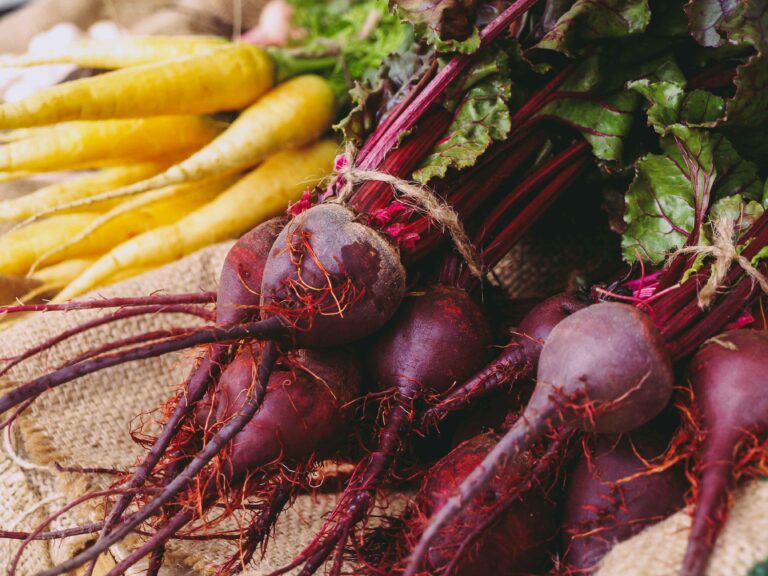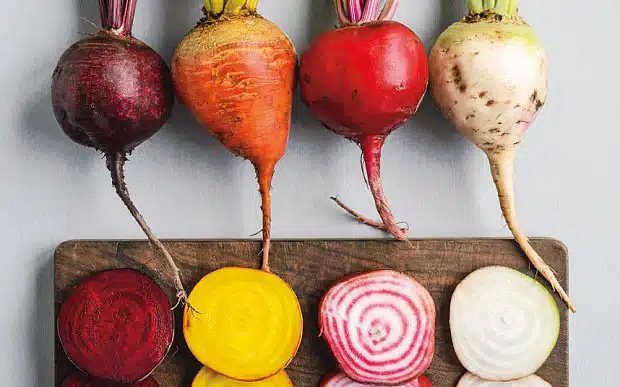Food and Nutrition Education Resources
Veggie Spotlight: Beets!
By: Jaz Popa, 03/10/2023

What are Beets?
Beets are a sweet, earthy-tasting root vegetable in the Amaranthaceae family that come in many varieties, commonly including red beets, golden beets, Chioggia beets, and white beets, as seen in the photo below, respectively. Related to spinach, quinoa, chard, and amaranth, beets are known for their edible leaves, which can be enjoyed like chard or spinach, and root, which are delicious raw, cooked, canned, and pickled. Beets are high in riboflavin, folate, manganese, copper, and the antioxidant betaine and the greens are a great source of riboflavin, iron, and vitamins A, C, and K, making these root vegetables a superfood!
How to Tell When Beets are Ripe:
When selecting beets, look for smooth, firm exteriors with bright, non-wilted leaves. The smaller the root, the more tender it will be.
How to Store Beets:
Store beets separately from their leaves. Remove the leafy greens, leaving about an inch or two of the stems on the beets. Store the greens in a sealed container with a dry paper towel. Store the roots in a sealed container in a cool, dark place like a cellar or the fridge. When stored correctly, the roots can stay fresh for up to three months. Do not wash the roots or leaves until use, to prevent excess moisture and premature rot.
How to Freeze Beets:
1.) Wash beets and trim tops, leaving 1/2 inch of stems and tap root, to prevent bleeding of color during cooking.
2.) Cook in boiling water until tender. For small beets 25 to 30 minutes; for medium beets 45 to 50 minutes.
3.) Cool promptly in cold water.
4.) Peel by rubbing the skin off with your fingers (wear gloves to prevent staining) and remove stem and tap root.
5.) Slice as desired.
6.) Spread sliced, cooked beets on a cookie sheet, and flash freeze them to prevent the beets from freezing in clumps.
7.) Once frozen, pack beets in a sealed container and use within 1 year for best results.
How to Process Beets:
1.) To prevent staining, begin with gloves and an apron.
2.) Don’t peel beets raw; instead, begin by cooking them until fork tender, by following the above instructions.
3.) Once the beets are fork-tender and cool, the skins will slide right off. Use your gloved hands to rub the skins off over the sink to prevent further messes. However, the skin is edible if you choose not to remove it.
4.) Before chopping, line your cutting board with parchment paper or a thin coat of vegetable oil to prevent stains on your cutting board.
5.) Remove the stem and tap root. This will also create a flat surface for you to safely chop the beet without it rolling around.
6.) Slice to your desired shape.
To learn more about how to prepare beets without creating a mess, click the button below.
How to Prepare Beets:
Beets are an incredibly versatile food; they are delicious raw, roasted, canned, pickled, grilled, seamed, and due to their high sugar content, as juice or in desserts!
To prepare beets, follow the directions above or try the methods listed below.
To cook whole, unpeeled beets:
Microwave – pierce the skin and place in microwave-safe dish with 2 to 4 tablespoons of water. Cover and microwave on HIGH for 10 to 15 minutes depending on size and number of beets.
Oven – place washed and trimmed beets on a piece of foil, drizzle with oil and seal edges closed. Bake for 45 to 60 minutes on 400F. Once cooled, remove ends and skin if desired. Season with your favorite seasonings such as salt, pepper, warm spices (allspice, cumin, cinnamon, paprika), and herbs (thyme, parsley, mint, basil).
Slow cooker – wrap each beet in foil. Cook for 2 to 4 hours on HIGH.
To cook cut, unpeeled beets:
Roast– place on a baking pan, drizzle with oil, sprinkle with salt, pepper and herbs as desired. Cook for about 45 minutes in a 400F to 425F oven.

